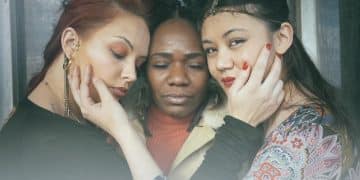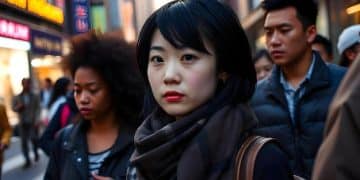The Evolution of Female Leads in J-Dramas: A Captivating Look

The Evolution of Female Leads in J-Dramas showcases a shift from traditional portrayals to complex, multifaceted characters tackling societal issues and defying expectations, reflecting changing cultural norms and offering viewers diverse and empowering narratives.
Japanese dramas, or J-Dramas, have captivated audiences worldwide, and a significant reason for their appeal lies in the compelling narratives and relatable characters. Specifically, the evolution of female leads in J-Dramas reflects broader societal shifts and changing perceptions of women, making it a fascinating topic to explore.
The Early Stages: Traditional Roles in J-Dramas
In the early days of J-Dramas, female characters were often relegated to traditional roles, reflecting the prevailing social norms of the time. These portrayals typically centered around domesticity, obedience, and a focus on marriage and family life.
These women were often portrayed as passive and supportive figures, primarily defined by their relationships with male characters. Their independence and personal ambitions were frequently sidelined in favor of fulfilling societal expectations.
Common Character Tropes
Several recurring character tropes characterized these early female leads. The “Yamato Nadeshiko,” an idealized vision of Japanese womanhood, was a frequent archetype. This woman was demure, graceful, and devoted to her family, embodying traditional virtues. Another common trope was the damsel in distress, a woman who required rescue by a male protagonist.
- The “Yamato Nadeshiko”: An epitome of traditional Japanese beauty and virtue.
- The Damsel in Distress: Dependent on male characters for rescue and validation.
- The Supportive Wife/Mother: Whose life revolves around her husband and children’s needs.
These portrayals, while reflecting the cultural context of the time, often lacked depth and complexity, limiting the range of female experiences depicted on screen. As society began to evolve, so too did the representation of women in J-Dramas.
In conclusion, the early stages of J-Dramas predominantly featured female characters in traditional, often one-dimensional roles that mirrored societal expectations of women. The emergence of more diverse and empowered female leads in later years marked a significant shift in the industry.
The Rise of Independent Women
As Japan underwent significant social and economic changes, J-Dramas began to reflect the evolving roles of women in society. This period saw the rise of independent female characters who challenged traditional norms and pursued their own ambitions.
These women were often portrayed as career-oriented, independent, and assertive. They defied expectations by prioritizing their personal goals and refusing to be defined solely by their relationships with men.

Key Characteristics of Independent Female Leads
Independent female leads in J-Dramas often possessed a strong sense of self-worth and were unafraid to challenge the status quo. They were depicted as intelligent, capable, and driven, pursuing careers in fields such as law, medicine, and business.
They faced obstacles and prejudices in their professional lives but persevered through determination and resilience. These characters provided a refreshing contrast to the earlier, more passive portrayals of women.
- Career-Driven: Prioritizing professional aspirations and excelling in their chosen fields.
- Assertive and Confident: Unafraid to voice their opinions and stand up for themselves.
- Resilient: Overcoming societal obstacles and challenging gender stereotypes.
This shift in representation not only reflected the changing realities of Japanese society but also inspired many viewers who saw themselves in these independent and ambitious characters.
This section concludes with the understanding that the emergence of independent female leads in J-Dramas mirrored the societal shift towards greater gender equality, offering viewers relatable and empowering portrayals of women breaking free from traditional constraints.
Addressing Social Issues Through Female Characters
A significant development in the Evolution of Female Leads in J-Dramas is the increasingly frequent use of female characters to explore and address social issues. This approach allows dramas to tackle complex topics such as gender inequality, workplace discrimination, and societal expectations.
By placing female characters at the center of these narratives, J-Dramas can shed light on the challenges women face and promote greater awareness and understanding. This approach makes it easier to deal with specific issues that Japanese women face in their day to day.
Examples of Socially Conscious J-Dramas
Several J-Dramas have successfully used female characters to address social issues. For instance, dramas focusing on women in the workplace often depict the challenges of balancing career and family, as well as the persistence of gender discrimination.
Other dramas have explored themes such as domestic violence, sexual harassment, and the pressures of conforming to societal beauty standards. By portraying these issues through the experiences of female characters, J-Dramas can spark important conversations and promote social change.
- Gender Inequality: Highlighting disparities in pay, promotion, and opportunities.
- Workplace Harassment: Addressing the prevalence and impact of sexual harassment in professional settings.
- Societal Expectations: Examining the pressures on women to conform to traditional roles and beauty standards.
The use of female characters to address social issues has not only enriched the storytelling of J-Dramas but has also made them more relevant and impactful for audiences.
To summarize, using female characters to address social issues has enabled J-Dramas to tackle complex topics and promote social awareness, enriching the narrative and resonating more deeply with audiences seeking meaningful content.
Complex Relationships and Emotional Depth
Contemporary J-Dramas have moved beyond simplistic romantic storylines to explore more complex relationships and emotional depths in their female characters. This involves portraying a wider range of human experiences and emotions, making the characters more relatable and authentic.
Female leads are now often depicted as having flaws, insecurities, and inner struggles, which adds depth and complexity to their personalities. This approach allows for a more nuanced exploration of relationships and emotions.

Exploring the Inner Lives of Female Characters
Modern J-Dramas delve into the inner lives of female characters, exploring their motivations, fears, and desires. This involves showcasing their vulnerabilities and imperfections, making them more human and relatable.
These characters are not always strong and confident; they may struggle with self-doubt, anxiety, and loneliness. By portraying these emotions honestly, J-Dramas can create a deeper connection with viewers.
- Flawed Protagonists: Characters with vulnerabilities and imperfections.
- Emotional Range: Portraying a wide spectrum of emotions beyond happiness and romance.
- Authentic Relationships: Depicting complex and realistic relationships with friends, family, and romantic partners.
This focus on emotional depth has allowed J-Dramas to create more compelling and engaging narratives, attracting a wider audience who appreciate the authenticity and complexity of the characters.
In essence, the exploration of complex relationships and emotional depth in female characters has elevated J-Dramas, providing more authentic and relatable portrayals that resonate with audiences seeking genuine and nuanced storytelling.
Popular J-Dramas with Iconic Female Leads
Several J-Dramas have featured iconic female leads who have left a lasting impression on audiences. These characters have not only entertained viewers but have also challenged societal norms and inspired positive change.
These dramas showcase the diversity and complexity of female experiences, demonstrating the power of representation in popular culture. They serve as examples of how J-Dramas have evolved in their portrayal of women.
Notable Examples of Iconic Female Leads
One notable example is the lead character in “Hanzawa Naoki,” who defies expectations in the male-dominated world of banking. Her determination, intelligence, and unwavering commitment to justice have made her a beloved figure among viewers.
Another example is in “Kahogo no Kahoko,” a drama about a sheltered young woman who learns to navigate the world on her own. Her journey from naivety to independence is both heartwarming and inspiring.
- “Hanzawa Naoki”: A strong and determined woman in the banking industry.
- “Kahogo no Kahoko”: A sheltered woman’s journey to independence.
- “Nigeru wa Haji da ga Yaku ni Tatsu” (We Married as a Job): A unique take on modern relationships with a strong female lead.
These are just a few examples of the many J-Dramas that have featured memorable and impactful female leads. Their success demonstrates the audience’s appetite for complex and empowering female characters.
These dramas demonstrate the impact of well-developed female characters in popular culture, showcasing diversity, challenging norms, and offering viewers empowering stories that resonate deeply through inspiring and nuanced storytelling.
Future Trends in Female Lead Characters
Looking ahead, it is likely that the evolution of female leads in J-Dramas will continue to reflect societal changes and evolving audience expectations. Future trends may include even greater diversity in terms of race, ethnicity, and sexual orientation.
Additionally, J-Dramas may explore more complex and nuanced themes related to gender identity, mental health, and social justice. As society becomes more diverse and inclusive, the representation of women in J-Dramas is likely to follow suit.
- Increased Diversity: Reflecting a wider range of backgrounds and experiences.
- Exploration of Complex Themes: Tackling issues such as gender identity and mental health.
- Empowerment and Agency: Portraying women as active agents in their own lives and communities.
By embracing these trends, J-Dramas can continue to push boundaries and offer viewers fresh and compelling stories that resonate with their lives and experiences.
In short, future trends in J-Dramas will likely focus on greater diversity, exploration of complex themes, and enhanced empowerment, reflecting societal progress and offering audiences relevant and engaging storytelling.
| Key Trend | Brief Description |
|---|---|
| 🌟 Traditional Roles | Early J-Dramas often showed women in domestic, supportive roles. |
| 💼 Independent Women | More recent dramas feature career-driven, assertive female leads. |
| 📢 Social Issues | Female characters now address inequality and societal pressures. |
| 💖 Emotional Depth | Contemporary leads show complex emotions and flaws. |
Frequently Asked Questions
▼
In early J-Dramas, female characters were often depicted in traditional roles, such as supportive wives or damsels in distress, primarily focused on domesticity and their relationships with male characters.
▼
Societal changes and economic shifts led to the rise of independent female leads, reflecting women’s evolving roles. These characters prioritize careers and challenge traditional norms, mirroring real-world progress.
▼
Modern J-Dramas place female characters at the forefront of narratives tackling gender inequality, workplace discrimination, and societal expectations, raising awareness and encouraging crucial conversations about these issues.
▼
Iconic female leads can be found in dramas like “Hanzawa Naoki,” showcasing a strong woman in banking, and “Kahogo no Kahoko,” following a sheltered woman’s journey to independence, among others.
▼
Future trends may include greater diversity, exploration of complex themes like gender identity and mental health, and empowering narratives where women take active roles in their lives and communities, offering fresh and relatable stories.
Conclusion
The evolution of female leads in J-Dramas reflects a broader cultural shift towards greater gender equality and a desire for more diverse and authentic representation. From traditional roles to independent and socially conscious characters, J-Dramas have showcased the changing realities of women’s lives. As society continues to evolve, so too will the portrayal of female leads in J-Dramas, offering viewers compelling stories that resonate with their experiences and aspirations.





